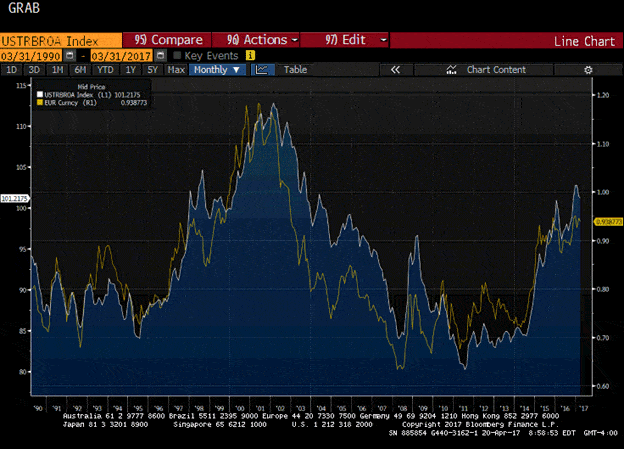Analysts at BBH argue that the Federal Reserve's real broad trade-weighted dollar fell for the first three months of 2017, and the greenback's heavy tone this month has raised questions about the state of the bull market and add that despite this recent weakness, they think the bull market is intact and that the advance will resume.
"In the February through April last year, the real broad trade-weighted measure of the dollar fell. Many investors doubted the bull market was intact. The greenback proceeded to rally seven of the following eight months. In 2015, this measure of the dollar fell in three of the 12 months, and two were back-to-back (April and May). In 2014, there was a three-month losing streak (March-May). It then appreciated in six of the following seven months. Of course, history does not repeat itself."
"The chart here depicts the real broad trade-weighted index(white line) and the euro (yellow line). The chart goes back to 1990. I am uncomfortable showing two time series on two scales on a single chart, as this practice seems abused on Wall Street. However, for given this, the two track each other pretty closely and for good fundamental reasons. Europe is a significant US trade partner and shares many of the same drivers of headline inflation, like energy."

"To assess the dollar's bull market in a disciplined fashion, and to avoid getting caught up in short-run disruptions, we come back to our assessment of the driver. We argue that first significant dollar rally post-Bretton Woods (the Reagan dollar rally) was driven by the policy mix of loose fiscal policy and tight monetary policy (under Volcker). The second dollar rally (Clinton dollar rally) was driven by the carving out of the internet (leading to the tech bubble)/ We note that the Fed began raising rates in 1994 and the dollar's bull market began in the spring of 1995."
"We see the current dollar rally (Obama-Trump), the third since Bretton Woods. What allowed us to anticipate it was our understanding of the driver: Divergence of monetary policy broadly understood. The Federal Reserve responded early and aggressively to the financial crisis. It began its unorthodox policies in 2009, several years before the Bank of Japan and the ECB began their efforts. This, coupled with the flexibility of the US economy, produced results earlier, allowing the Fed to exit and begin normalizing policy before most of the rest of the world."
"The question of the state of the dollar bull market is a question, in our mind, of whether divergence remains intact. We think it does. Softer Q1 GDP, with the pullback in consumption, we judge as a temporary soft patch. Growth in the January-March period has been typically soft beginning in 2010. From 2010 through 2016, growth in Q1 has averaged 1.1%. Growth in all the other quarters has averaged 2.5%."
"The key to consumption is income. Wages are an important part of income. More people are working earning a little bit more per hour. This can be expected to continue to underpin consumption on a trend basis. The recovery of the oil patch should support business investment. Over the past year, exports have grown four times faster than the growth of the overall economy. Despite the past dollar rally, the trade deficit has not deteriorated and remains near its 12- and 24-months."
"Investors may have gotten ahead of themselves in anticipating that President Trump's economic agenda of deregulation, tax reform, and infrastructure spending would boost growth. The legislative agenda, as opposed to executive orders, is proving more difficult than many assumed given the Republican majorities. On the other hand, as noted by the Fed's Vice Chairman Fischer earlier this week, and concurring with the IMF, the global economy is in somewhat better shape. "
Information on these pages contains forward-looking statements that involve risks and uncertainties. Markets and instruments profiled on this page are for informational purposes only and should not in any way come across as a recommendation to buy or sell in these assets. You should do your own thorough research before making any investment decisions. FXStreet does not in any way guarantee that this information is free from mistakes, errors, or material misstatements. It also does not guarantee that this information is of a timely nature. Investing in Open Markets involves a great deal of risk, including the loss of all or a portion of your investment, as well as emotional distress. All risks, losses and costs associated with investing, including total loss of principal, are your responsibility. The views and opinions expressed in this article are those of the authors and do not necessarily reflect the official policy or position of FXStreet nor its advertisers. The author will not be held responsible for information that is found at the end of links posted on this page.
If not otherwise explicitly mentioned in the body of the article, at the time of writing, the author has no position in any stock mentioned in this article and no business relationship with any company mentioned. The author has not received compensation for writing this article, other than from FXStreet.
FXStreet and the author do not provide personalized recommendations. The author makes no representations as to the accuracy, completeness, or suitability of this information. FXStreet and the author will not be liable for any errors, omissions or any losses, injuries or damages arising from this information and its display or use. Errors and omissions excepted.
The author and FXStreet are not registered investment advisors and nothing in this article is intended to be investment advice.
Recommended content
Editors’ Picks
AUD/USD rises to two-day high ahead of Aussie CPI

The Aussie Dollar recorded back-to-back positive days against the US Dollar and climbed more than 0.59% on Tuesday, as the US April S&P PMIs were weaker than expected. That spurred speculations that the Federal Reserve could put rate cuts back on the table. The AUD/USD trades at 0.6488 as Wednesday’s Asian session begins.
EUR/USD now refocuses on the 200-day SMA

EUR/USD extended its positive momentum and rose above the 1.0700 yardstick, driven by the intense PMI-led retracement in the US Dollar as well as a prevailing risk-friendly environment in the FX universe.
Gold struggles around $2,325 despite broad US Dollar’s weakness

Gold reversed its direction and rose to the $2,320 area, erasing a large portion of its daily losses in the process. The benchmark 10-year US Treasury bond yield stays in the red below 4.6% following the weak US PMI data and supports XAU/USD.
Bitcoin price makes run for previous cycle highs as Morgan Stanley pushes BTC ETF exposure

Bitcoin (BTC) price strength continues to grow, three days after the fourth halving. Optimism continues to abound in the market as Bitcoiners envision a reclamation of previous cycle highs.
Australia CPI Preview: Inflation set to remain above target as hopes of early interest-rate cuts fade

An Australian inflation update takes the spotlight this week ahead of critical United States macroeconomic data. The Australian Bureau of Statistics will release two different inflation gauges on Wednesday.